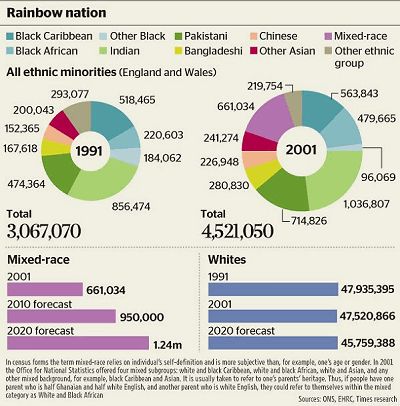|
||
|
|
Rainbow generation presents a new image of strength, success and self-confidence
“The emergent findings challenge long-standing ideas of ‘mixed’ families on several levels. More than half of dependent children have married or cohabiting parents, whose socioeconomic circumstances denote a strong middle-class dimension to mixed families. It questions the dominant underclass stereotype.” The Millennium Cohort Study, which examines 15,000 children born in 2000 and 2001, found that by the age of 3, cognitive outcomes varied considerably among ethnic groups. Bangladeshi and Pakistani children were the furthest behind at this age, with Indian, Black African and Black Caribbean children of average development. But white and mixed-race children showed above-average development. By the age of 11, ethnic differences had reduced and continued to do so throughout secondary school. However, they open up again at post-18 education. Mixed-race students are the largest ethnic minority at Oxford and Cambridge at 3.3 per cent and 2.5 per cent respectively. Of all those mixed-race students in higher education, more than 30 per cent are at the Russell Group of elite universities compared with 21 per cent of white students. That is not to say that mixed-race families do not have problems or face discrimination. There is higher unemployment among mixed-race people than among white or Asian groups. They are more likely to be victims of crime than any other group, although the predominance of young people in this group may be part of the explanation. Mixed-race children are also over-represented in the care population and wait for longer to be adopted. The latest research on intermarriage suggests that some communities that have been in Britain for more than two centuries may be at risk of disappearing. Nearly half (48 per cent) of British Black Caribbean men and a third of British Caribbean women in a long-term relationships are with someone from a different ethnic group. Among those with children, the numbers are even higher, at 55 per cent for men and 40 per cent for women. Lucinda Platt, reader in sociology at the University of Essex, who made the finding, said: “This trend is set to continue, and that will result in an increasing number of people with diverse identities of which Caribbean heritage forms a part. It also means that those who define themselves as singularly Caribbean are likely to decline over time.” Over the past 14 years the number of children of Caribbean heritage with one white parent has risen from 39 per cent to 49 per cent. Among the Indian population it has increased from 3 per cent to 11 per cent, for Pakistanis from 1 per cent to 4 per cent, and for Chinese from 15 per cent to 35 per cent. 780 words Annotations: * prevalent - weit verbreitet, vorherrschend * assumption - Annahme, Vermutung * to perceive - wahrnehmen * to constitute - darstellen, bezeichnen * promiscuous - vermischt, buntgewürfelt * feckless - nutzlos, untauglich Assignments: 1. What stereotypes exist concerning mixed-race partnerships and children from these partnerships and, in contrast, what does reality look like? 2. How do children from different ethnic groups progress from the age of 3 until they enter higher education? Take into account: - Bangladeshi and Pakistani children - Black African children - mixed-race children (all living in the UK) 3. What do you think can account for the fact that unemployment among mixed-race people is higher than among white or Asian people? 4. The trend of European countries turning into multicultural societies is obviously growing. What do you think are the reasons for this trend and what consequences will politicians have to face if this trend continues? |
| © 1997-2025 englischlehrer.de × Alle Rechte vorbehalten. × Ausgewiesene Marken gehören ihren jeweiligen Eigentümern. englischlehrer.de übernimmt keine Haftung für den Inhalt verlinkter externer Internetseiten. 4.206 (+0)pi × search powered by uCHOOSE |
|

